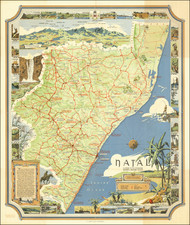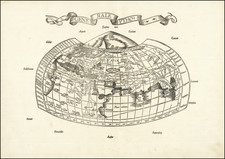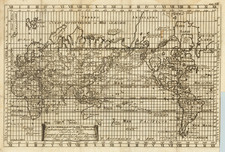Anti-Nuclear Poster Published Two Months After the Three Mile Island Accident
This map details the locations of areas of the United States which contribute to, and which are at risk from nuclear technologies. Nuclear weapon facilities, nuclear power reactors, miscellaneous other facilities, and nuclear targets are all shown.
The nuclear targets shown on the map comprise large parts of the United States. While many of these red splotches can be attributed to major cities or military installments, the nature of other targets in remote areas is more unclear. However, every state has at least several targets, which would have made for a very useful campaigning tool for those afraid of nuclear weapons and disasters.
The map is simple, with few primary colors, but it does a very good job of presenting a frightening image of the risks America faces. The verso harnesses that fear and instructs the reader on how to successfully oppose nuclear power and weapons. Some of the claims on the back of the map are debatable, such as discussing how the spread of nuclear power will lead to the spread of nuclear weapons or claiming that the industry is so capital-intensive so as to not be a good source of jobs.
An excerpt on the verso text states that:
Nukes (nuclear weapons and nuclear power plants) present the greatest threat to life ever known. We cannot permit this threat to continue -- or to continue escalating.
This map was produced to graphically illustrate the magnitude and pervasiveness of the nuclear menace, to help stimulate organizing against nukes, and to emphasize the inseparable link between weapons and power.
Further text on the verso includes a list of nuclear installations in the US by Location, name of owner or contractor, and a description of what occurs at each location (mining, nuclear power reactors, weapons storage, fuel processing, etc.).
This is the second state of the map, dated June 1979. The Three Mile Island accident had occurred just on March 28th of that year. The incident led to the evacuation of hundreds of thousands of Pennsylvanian residents for a period of several weeks, though no lasting health impacts were noted. Organizations such as the War Resisters League used the event to change the tide of public sentiment, and nuclear power went from a fast-growing industry to one that languished, at least in the United States.
The War Resisters League and Opposition to Nuclear Violence
The demise of the Soviet Union and has seen a plummet in public and government interest in nuclear technologies, with ambivalence common regarding these issues. While little has changed in terms of nuclear arsenals, the movement to denuclearize peaked in the late 1970s and early 1980s, with demonstrations regularly attracting hundreds of thousands in the US. A June 1982 protest was one of the largest political demonstrations in the United States, with well over a million participants. These protests were fueled by participants who had grown up during the height of the Cold War and saw the continued expansion of nuclear weapons, particularly the NATO deployment of intermediate-range nuclear forces in Europe, as existential threats. The Three Mile Island incident, as previously described, served only to increase these fears and leverage this fear of nuclear weapons against nuclear energy.
The War Resisters League helped take the forefront of the anti-nuclear movement, adopting a position not only against nuclear weapons but also against nuclear power. The League had gained popularity during the Civil Rights and Vietnam War protests and used its influence to help start the mass-nuclear weapon protests of the era.












![[San Diego & Vicinity] Home Federal Country](https://storage.googleapis.com/raremaps/img/small/71369.jpg)



![Hawaii - The Aloha State [Aloha Airlines]](https://storage.googleapis.com/raremaps/img/small/86140.jpg)